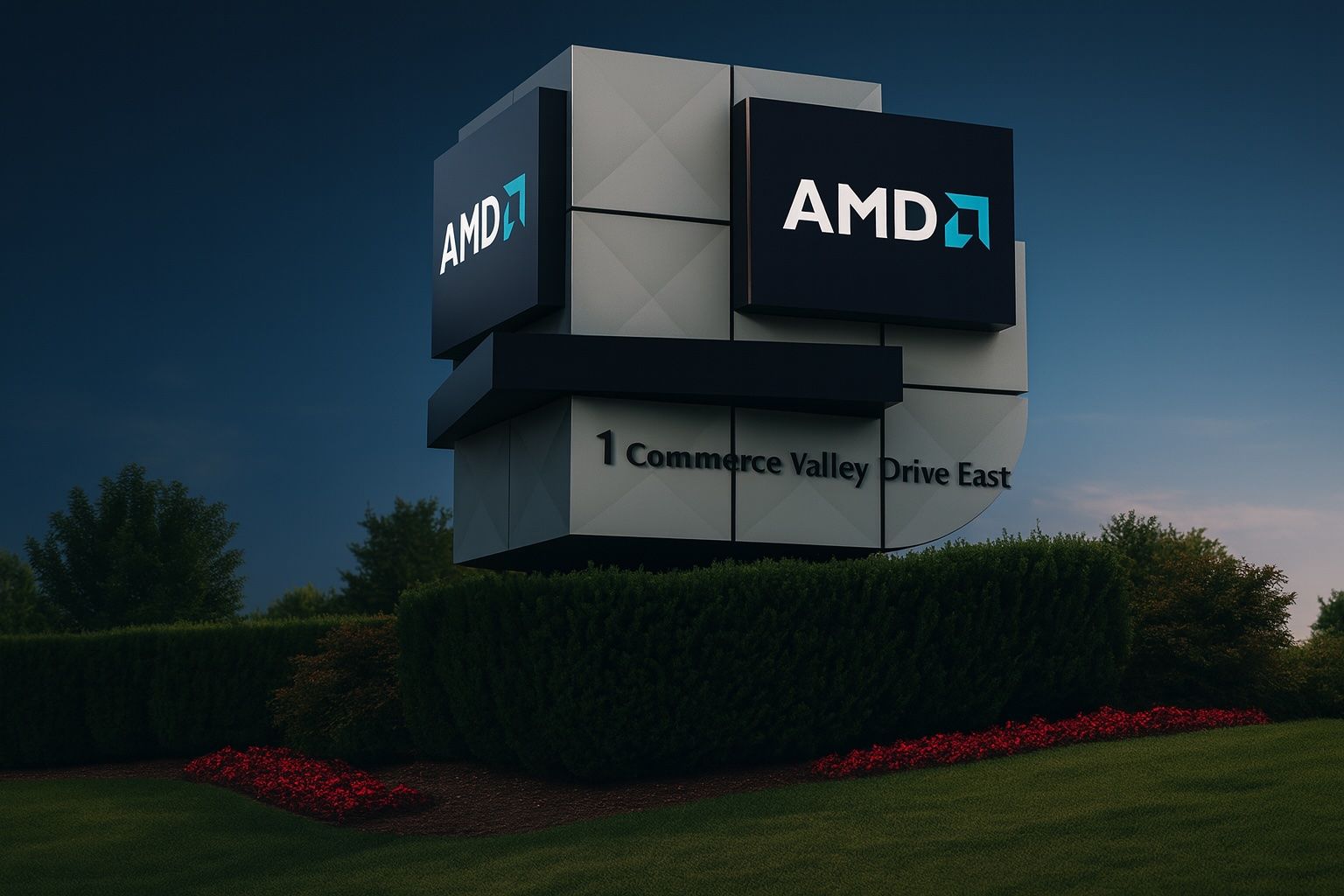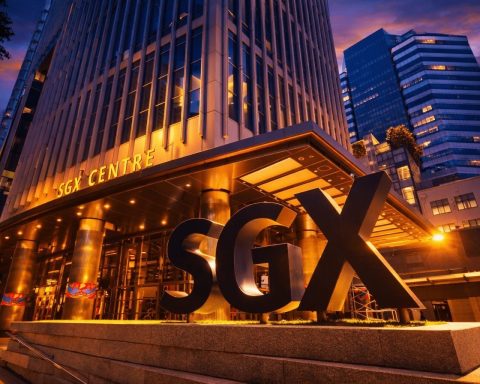- Trading around $230 (Oct. 23, 2025): AMD shares are near $230, modestly off mid-October highs (~$238–$240) [1] [2]. This comes after a wild October, including a 34% one-day surge on Oct. 6, and an overall YTD gain of roughly 80% [3] [4].
- Recent swings: Mid-October rallies have cooled. For example, AMD jumped 9.4% on Oct. 15 (closing ~$239) [5] but then eased – up 3.2% on Oct. 20, before slipping ~1–3% on Oct. 21–22 [6]. (As of Oct. 22 close: $230.23, down ~3.3% that day [7].)
- AI mega-deals: Early October deal announcements drove the rally. On Oct. 6 AMD unveiled a multi-year pact to supply 6 gigawatts of its Instinct GPUs to OpenAI – a deal touted to bring “tens of billions” in revenue [8] [9]. That news sent AMD stock +34% in one day [10]. A week later (Oct. 14), Oracle Cloud announced it will deploy 50,000 of AMD’s upcoming MI450 GPUs in new AI superclusters [11] [12]. Each of these AI partnerships gave AMD a stock lift (Oracle news spiked shares ≈3% pre-market [13] [14]).
- Other partnerships: Beyond OpenAI/Oracle, AMD has built more collaborations. In early Oct., AMD/IBM announced a multi-year deal to equip Zyphra’s AI lab with AMD Instinct MI300X GPUs on IBM Cloud – “among the largest” AI training clusters to date [15]. In September, AMD expanded its work with AI software vendor Cohere, certifying Cohere’s models (Command AI suite) on AMD GPU infrastructure and even integrating Cohere’s software into AMD’s own AI platform [16].
- New products and platforms: AMD is rolling out AI-ready hardware. At the Oct. 14 Open Compute Project summit, AMD showed off its new “Helios” rack-scale AI system – an open-standard data-center chassis built on EPYC CPUs, Instinct GPUs and open networking [17] [18]. Helios is aligned with Meta’s new “Open Rack Wide” spec for large AI clusters. Oracle said its future “AI superclusters” will use AMD’s Helios racks [19]. (For gaming/PC markets, AMD also unveiled new Radeon RX 9060 XT GPUs and Threadripper 9000 CPUs at Computex 2025 [20], underscoring continued product innovation.)
- Analyst targets & sentiment: Wall Street has turned very bullish. Over a dozen analysts have raised AMD’s 12-month price targets into the $250–$300 range [21]. HSBC now pegs $310 [22], and Jefferies/Wolfe both raised targets to $300 [23], reflecting the booming AI outlook. About 60–65% of analysts rate AMD a “Buy” after the AI deals (vs. ~50% before) [24]. Hedge funds and bloggers note that AMD’s recent financial results were strong: Q2 profit surged 229% year-over-year on double-digit revenue growth (helped by data-center and AI demand) [25]. One market report summarizes: “Analysts said it was a major vote of confidence in AMD’s AI chips… but is unlikely to dent Nvidia’s dominance” [26].
AI Deals Ignite a Rally
The catalyst for AMD’s October surge was clear: blockbuster AI contracts. On Oct. 6, AMD announced it would supply hundreds of thousands of GPUs (roughly 6 gigawatts of compute) to OpenAI over several years [27]. AMD executives hailed the pact as transformative. EVP Forrest Norrod called it “certainly transformative, not just for AMD, but for the dynamics of the industry” [28]. CFO Jean Hu said the OpenAI deal should “deliver tens of billions of dollars in revenue” and be “highly accretive” to future earnings [29]. OpenAI CEO Sam Altman added that having AMD chips “will allow [us] to build enough AI infrastructure to meet [our] needs” [30].
The market reaction was immediate. AMD stock jumped 34% on Oct. 6 alone, its biggest one-day gain in nearly a decade [31]. That one-day spike added roughly $80 billion to AMD’s market value [32], as investors saw it as validation that major AI players were diversifying beyond Nvidia. (Intel competitor: Leah Bennett of Westwood told Reuters: “AMD has really trailed Nvidia… I think [the deal] helps validate their technology” [33].)
Just days later, on Oct. 14, Oracle announced it will build AI supercomputer clusters on AMD hardware [34]. Oracle’s cloud division will install 50,000 of AMD’s next-gen MI450 GPUs (plus EPYC CPUs and AMD’s Helios racks) starting in late 2026 [35]. The companies said demand for large-scale AI capacity is “accelerating” as models grow more complex [36]. Even though the Oracle news came in a volatile market, AMD stock ticked up about 3% on the announcement [37].
In sum, these deals suggest $100+ billion in potential new revenue for AMD over the next several years [38] [39]. Analysts now model hundreds of millions of new GPU shipments for AMD, with bulls arguing that each 1 gigawatt of AI capacity could translate to $20 billion in AMD sales [40]. (Wedbush’s Matt Bryson raised his earnings forecast and price target to $270 on this news [41].) Even Morgan Stanley and Goldman, historically cautious on AMD, have upgraded their outlook on the company given these signed orders [42].
Partnerships and Ecosystem Expanding
Beyond OpenAI and Oracle, AMD has been busy building an AI ecosystem. In early October, IBM and AMD announced a collaboration to deploy AMD Instinct MI300X GPUs on IBM Cloud for Zyphra, a billion-dollar open-source AI startup [43]. Zyphra is now training large multimodal AI models on one of the largest AMD-powered GPU clusters ever built [44]. AMD’s full-stack AI platform (compute + networking + DPUs) was integrated on IBM Cloud, with IBM calling it “a new standard in AI infrastructure” [45]. This shows AMD is targeting not just hyperscalers but also enterprise and sovereign AI labs seeking open alternatives.
Similarly, AMD has deepened its partnership with Cohere, a leading enterprise AI firm. In September, AMD announced that Cohere’s entire suite of enterprise AI models (Command AI and North) will be optimized for and sold on AMD GPU-based systems [46]. Cohere says this gives customers more flexibility and better total cost of ownership for sensitive AI workloads [47]. In fact, AMD is integrating Cohere’s “North” platform into its own internal AI workflows [48], underscoring how AMD is weaving third-party AI software into its products.
Altogether, these collaborations – with OpenAI, Oracle, IBM, Cohere, and others – demonstrate AMD’s strategy as a flexible “open” alternative. Unlike a closed ecosystem, AMD’s Instinct GPUs and new Helios rack servers (launched Oct. 14) use standard, open interfaces so hyperscalers and enterprises can mix-and-match AMD hardware with other vendors [49] [50]. For example, AMD says its Helios design (built to Meta’s new “Open Rack Wide” standard) will let OEMs deploy customizable AI racks quickly [51]. Oracle’s superclusters are planned around Helios frames [52], putting pressure on Nvidia’s proprietary DGX systems. As one analyst quipped, AMD is offering an “open, secure, and scalable” AI foundation versus Nvidia’s closed boxes [53].
Stock Performance and Valuation
AMD’s stock rally has been extraordinary. It nearly doubled this year [54], far outpacing most peers. For context, TS2.Tech notes AMD was up ~80% YTD as of mid-October, whereas NVIDIA (NVDA) was up ~40% and Intel only marginally higher [55]. AMD’s market capitalization is now on par with Intel’s and trailing only Nvidia (the world’s largest chipmaker at about $4 trillion) [56] [57]. In fact, the Philadelphia Semiconductor Index (SOX) is up ~32% in 2025, so AMD’s gain is a standout even among hot chip stocks [58].
That said, analysts caution that AMD’s valuation is extremely rich. TS2.Tech reports AMD now trades around 40× 2026 earnings (and its trailing P/E is over 100×) [59]. This is even higher than Nvidia’s (roughly 30×). In other words, AMD’s forward multiples (~125× if current growth slows) leave “little room for error” if the AI hype proves too optimistic [60] [61]. Some firms (Goldman Sachs, Citi) remain neutral, warning that much of the future growth is already priced in [62]. Their price targets (~$210) are well below current levels, reflecting caution.
Nonetheless, bullish strategists highlight AMD’s long-term upside. Bank of America, for example, forecasts AMD on a “path to $10+” annual EPS by 2027 given the AI roadmap [63] – implying massive stock upside from today’s ~$1 EPS. (Notably, OpenAI’s warrant deal would only fully vest if AMD’s stock hit about $600 – underscoring how big the potential is in these AI bets [64].) More modestly, many expect AMD to keep capturing CPU and GPU market share. Wedbush’s Matt Bryson, a longtime AMD bull, argues that every gigawatt of deployed AI capacity could be worth roughly $20 B in chips, and that AMD’s newly secured orders might exceed his previous forecasts [65]. He raised his AMD price target from $190 to $270 on this thesis [66].
Competition: NVIDIA and Intel
AMD’s gains occur in a landscape still dominated by rivals. NVIDIA remains the indisputable leader in AI chips. Its data-center GPUs command ~90+% of the market [67]. Nvidia’s stock has also rocketed – up 171% in 2024 and another ~30–40% this year [68] – and it now boasts a roughly $4 trillion market cap [69]. Many Wall Street surveys still rate NVIDIA as a higher “Buy” consensus than AMD. In the short term, analysts note AMD’s wins are unlikely to dislodge Nvidia’s lead (Nvidia is simply selling every chip it can make) [70] [71].
Intel is trying to re-enter the race. In mid-Oct, Intel unveiled a new AI chip (code-named Crescent Island) aimed at inference workloads [72]. It will launch next year with 160 GB of a new memory, optimized for energy efficiency [73]. Intel’s CEO and CTO say they’ll release new AI chips annually to catch up to the 12-month cadence of AMD/Nvidia [74]. Notably, Nvidia agreed to invest $5 billion in Intel for a 4% stake to co-develop future chips [75] – a move that re-ignites Intel’s data-center focus. AMD positions itself as the “open” alternative in this mix: its Instinct accelerators and Helios racks can integrate with other vendors’ hardware [76], whereas Nvidia’s H100/A100 stacks are more proprietary.
In consumer markets, AMD also faces Intel in PCs/servers and Nvidia in gaming GPUs. But for the scope of AI/data-center investors, the big story is AMD trying to carve out a niche. If it succeeds, that could translate into years of strong growth. If not, the lofty valuation could come under pressure.
Outlook: Hope vs. Hype
Going forward, the debate is how well AMD can execute on these AI orders. Every major contract (OpenAI, Oracle, Zyphra, etc.) is contingent on AMD ramping up production and meeting performance milestones in 2026–2027. Even AMD warns that the $100 billion revenue figure is weighted toward the back half of the decade. In the near term (Q4 2025 and early 2026), investors will closely watch AMD’s earnings (Q3 due Nov. 4, 2025) to see signs of capacity building and price improvement [77].
For now, sentiment is bullish. As one AMD-watcher put it: these AI deals finally give AMD the “revenue certainty” its AI business needed [78]. AMD’s CEO Lisa Su and her team have demonstrated they can attract marquee AI clients. The question is whether supply chain, competition, or macro shocks will trip them up. The stock’s huge run-up has set sky-high expectations. Investors should note the warnings: even if growth stays strong, the current $230+ price already embeds a lot of bullish news [79] [80].
In summary, AMD is riding a wave of AI enthusiasm. Its stock price reflects big-picture hopes: that AMD can become a major supplier to the AI datacenters of OpenAI, Oracle, Google, and others. With analysts from Morgan Stanley to Wedbush forecasting ever-higher targets – some eyeing $300 or more [81] – the next few quarters will test whether AMD’s fundamentals can catch up to its outsize valuation.
Sources: Reuters, AMD investor releases, TS2.Tech analysis, and market-data sites [82] [83] [84] [85] [86] [87], among others.
References
1. www.trefis.com, 2. ts2.tech, 3. ts2.tech, 4. www.reuters.com, 5. www.investing.com, 6. www.investing.com, 7. www.investing.com, 8. www.reuters.com, 9. ts2.tech, 10. www.reuters.com, 11. www.reuters.com, 12. ts2.tech, 13. www.reuters.com, 14. ts2.tech, 15. newsroom.ibm.com, 16. ir.amd.com, 17. ir.amd.com, 18. www.reuters.com, 19. www.reuters.com, 20. ir.amd.com, 21. ts2.tech, 22. ts2.tech, 23. ts2.tech, 24. ts2.tech, 25. www.mitrade.com, 26. ts2.tech, 27. www.reuters.com, 28. www.reuters.com, 29. ts2.tech, 30. ts2.tech, 31. ts2.tech, 32. ts2.tech, 33. www.reuters.com, 34. www.reuters.com, 35. www.reuters.com, 36. www.reuters.com, 37. www.reuters.com, 38. ts2.tech, 39. www.reuters.com, 40. ts2.tech, 41. ts2.tech, 42. ts2.tech, 43. newsroom.ibm.com, 44. newsroom.ibm.com, 45. newsroom.ibm.com, 46. ir.amd.com, 47. ir.amd.com, 48. ir.amd.com, 49. ts2.tech, 50. ir.amd.com, 51. ir.amd.com, 52. www.reuters.com, 53. www.reuters.com, 54. ts2.tech, 55. ts2.tech, 56. ts2.tech, 57. ts2.tech, 58. ts2.tech, 59. ts2.tech, 60. ts2.tech, 61. ts2.tech, 62. ts2.tech, 63. ts2.tech, 64. ts2.tech, 65. ts2.tech, 66. ts2.tech, 67. ts2.tech, 68. ts2.tech, 69. ts2.tech, 70. ts2.tech, 71. www.reuters.com, 72. www.reuters.com, 73. www.reuters.com, 74. www.reuters.com, 75. www.reuters.com, 76. ts2.tech, 77. ts2.tech, 78. ts2.tech, 79. ts2.tech, 80. ts2.tech, 81. ts2.tech, 82. www.trefis.com, 83. ts2.tech, 84. ts2.tech, 85. www.reuters.com, 86. ir.amd.com, 87. www.reuters.com







